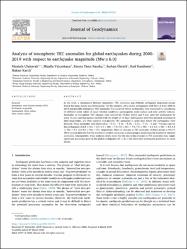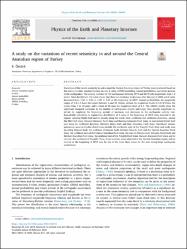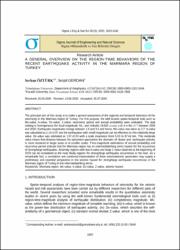Ara
Toplam kayıt 12, listelenen: 1-10
Analysis of ionospheric TEC anomalies for global earthquakes during 2000-2019 with respect to earthquake magnitude (Mw >= 6.0)
(Pergamon-Elsevier Science Ltd, 2020)
In this work, a relationship between ionospheric TEC anomalies and different earthquake magnitude groups before the main shocks was investigated. For this purpose, 2942 global earthquakes with Mw >= 6 from 2000 to 2019 and ...
A study on the variations of recent seismicity in and around the Central Anatolian region of Turkey
(Elsevier, 2020)
Variations of the recent seismicity in and around the Central Anatolian region of Turkey were evaluated based on the seismic b-value, standard normal deviate Z-value, GENAS modelling, annual probabilities and return periods ...
A comparison of alternative curve fitting techniques for different earthquake fault parameters of Iranian earthquakes
(Univ Nacional De Colombia, 2020)
In this study, we tried to estimate the optimum linear equations among the parameters associated with different earthquake fault mechanisms for Iranian earthquakes. For this purpose, we tested different curve fitting methods ...
A GENERAL OVERVIEW ON THE REGION-TIME BEHAVIORS OF THE RECENT EARTHQUAKE ACTIVITY IN THE MARMARA REGION OF TURKEY
(Yildiz Technical Univ, 2020)
The principal aim of this study is to make a general assessment of the regional and temporal behaviors of the seismicity in the Marmara region of Turkey. For this purpose, the well-known spatio-temporal tools such as ...
Tectonic and structural characteristics of Erzurum and its surroundings (Eastern Turkey): a detailed comparison between different geophysical parameters
(SCIENTIFIC TECHNICAL RESEARCH COUNCIL TURKEY-TUBITAK, 2022)
The tectonic and structural properties of Erzurum and its surroundings have been investigated by evaluating the seismotectonic b -value, magnetic anomaly, edge detection analysis (total horizontal derivative (THDR) and ...
Spatial variations of fundamental seismotectonic parameters for the earthquake occurrences in the Eastern Mediterranean and Caucasus
(SPRINGER, 2022)
In this study, a comprehensive statistical analysis was made for different parts of the world. For this purpose, fundamental seismotectonic earthquake parameters such as b-value, magnitude completeness, Mc-value stress ...
A comprehensive spatiotemporal evaluation of the current earthquake activity in different parts of the Frakull-Durres fault zone, Albania
(NST GEOLOGY & GEOGRAPHY, 2021)
This study presents a detailed spatiotemporal analysis for the Frakull-Durrds (F-D) fault zone at the beginning of 2020. For this purpose, the most frequently used statistical seismicity parameters such as magnitude ...
Tectonic and structural characteristics of Erzurum and its surroundings (Eastern Turkey): a detailed comparison between different geophysical parameters
(TUBITAK, 2022)
The tectonic and structural properties of Erzurum and its surroundings have been investigated by evaluating the seismo-tectonic b-value, magnetic anomaly, edge detection analysis (total horizontal derivative (THDR) and ...
Statistical behaviours of earthquake occurrences in the Central Anatolian Region of Turkey: region-time-magnitude analyses
(INST GEOLOGY & GEOGRAPHY, 2021)
Bu çalışmanın temel amacı, Türkiye'nin İç Anadolu Bölgesi'ndeki depremlerin istatistiksel davranışlarını tanımlayarak ayrıntılı bölge-zaman-büyüklük analizleri yapmaktır. Bu kapsamda Mcomp, b-değeri, Dc-değeri, Z-değeri, ...
A comprehensive spatiotemporal evaluation of the current earthquake activity in different parts of the Frakull-Durrës fault zone, Albania
(Nature Research Centre, 2021)
This study presents a detailed spatiotemporal analysis for the Frakull-Durrës (F-D) fault zone at the beginning of 2020. For this purpose, the most frequently used statistical seismicity parameters such as magnitude ...


















